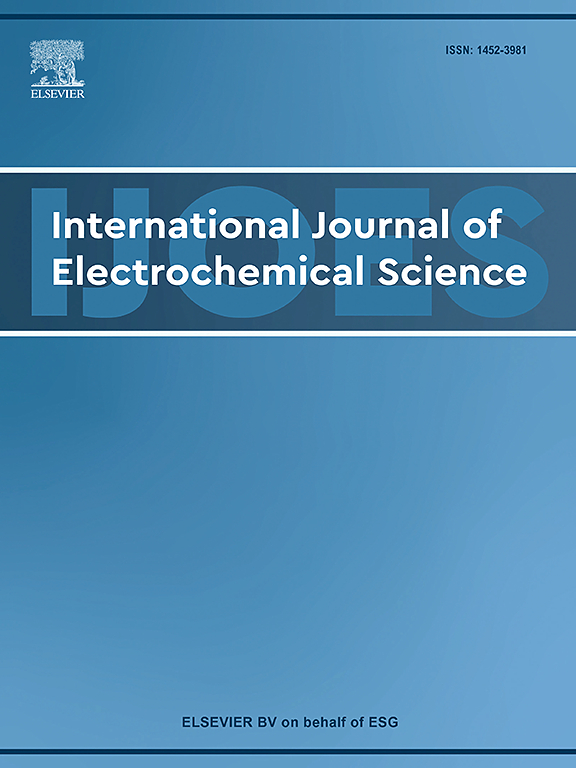Electrochemical approaches for detecting micro and nano-plastics in different environmental matrices
IF 2.4
4区 化学
Q4 ELECTROCHEMISTRY
International Journal of Electrochemical Science
Pub Date : 2025-09-13
DOI:10.1016/j.ijoes.2025.101182
引用次数: 0
Abstract
Microplastics and nanoplastics are synthetic polymer particles < 5 mm and < 1 μm respectively, have emerged as ubiquitous environmental contaminants with significant implications for ecosystem and human health. Conventional detection methods including FTIR spectroscopy, Raman microspectroscopy, and pyrolysis-GC/MS face substantial limitations including poor spatial resolution, matrix interference, time-intensive analysis, and high costs that hinder widespread monitoring efforts. Electrochemical sensing strategies offer promising alternatives, leveraging the inherent properties of plastic particles through direct detection via particle collision, indirect detection of electroactive additives, and recognition-based approaches using surface modifications. These methods provide exceptional sensitivity with detection limits reaching nanomolar concentrations, rapid response times of seconds to minutes, and significant cost advantages over traditional techniques. Advanced electrode modifications incorporating nanomaterials, molecularly imprinted polymers, and biological recognition elements enhance selectivity and sensitivity for diverse environmental matrices including water bodies, food products, and biological samples. Portable electrochemical sensors enable real-time, on-site monitoring capabilities previously unattainable with laboratory-based methods. Despite challenges in selectivity, reproducibility, and matrix interference, emerging hybrid platforms integrating electrochemical detection with complementary techniques, machine learning algorithms, and automated systems demonstrate significant potential for revolutionizing microplastic monitoring. This review critically evaluates current electrochemical approaches, identifies key limitations, and outlines future research directions toward practical field-deployable sensors for comprehensive environmental surveillance.
电化学方法在不同环境基质中检测微塑料和纳米塑料
微塑料和纳米塑料分别是合成聚合物颗粒<; 5 mm和<; 1 μm,已成为无处不在的环境污染物,对生态系统和人类健康具有重要影响。传统的检测方法,包括FTIR光谱、拉曼微光谱和热解- gc /MS,面临着很大的局限性,包括空间分辨率差、基质干扰、分析时间密集和成本高,阻碍了广泛的监测工作。电化学传感策略提供了有前途的替代方案,通过颗粒碰撞直接检测、电活性添加剂间接检测和基于表面修饰的识别方法来利用塑料颗粒的固有特性。这些方法具有卓越的灵敏度,检测限达到纳摩尔浓度,快速响应时间从几秒到几分钟,并且与传统技术相比具有显着的成本优势。结合纳米材料、分子印迹聚合物和生物识别元件的先进电极修饰提高了对各种环境基质(包括水体、食品和生物样品)的选择性和灵敏度。便携式电化学传感器可以实现实时、现场监测,这是以前实验室方法无法实现的。尽管在选择性、再现性和基质干扰方面存在挑战,但新兴的混合平台将电化学检测与互补技术、机器学习算法和自动化系统相结合,显示出微塑料监测革命的巨大潜力。这篇综述批判性地评估了当前的电化学方法,确定了关键的局限性,并概述了用于综合环境监测的实用现场可部署传感器的未来研究方向。
本文章由计算机程序翻译,如有差异,请以英文原文为准。
求助全文
约1分钟内获得全文
求助全文
来源期刊
CiteScore
3.00
自引率
20.00%
发文量
714
审稿时长
2.6 months
期刊介绍:
International Journal of Electrochemical Science is a peer-reviewed, open access journal that publishes original research articles, short communications as well as review articles in all areas of electrochemistry: Scope - Theoretical and Computational Electrochemistry - Processes on Electrodes - Electroanalytical Chemistry and Sensor Science - Corrosion - Electrochemical Energy Conversion and Storage - Electrochemical Engineering - Coatings - Electrochemical Synthesis - Bioelectrochemistry - Molecular Electrochemistry

 求助内容:
求助内容: 应助结果提醒方式:
应助结果提醒方式:


